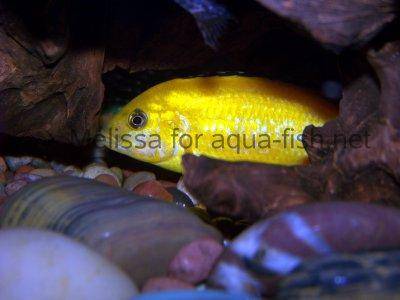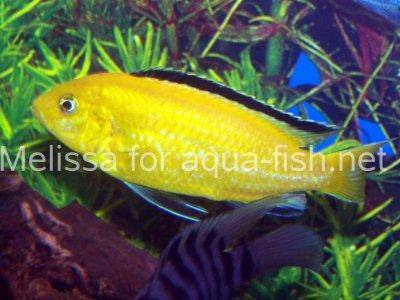Raising Electric Yellow Labs in Aquariums: A Complete Guide
Quick Links - Answers
Brief Description
This page offers a comprehensive guide on how to properly care for Electric Yellow Labs, covering feeding, breeding, tank setup, and compatibility with other fish. If you have questions or would like to share your experiences, feel free to join our community forum at the end of the article!
Introduction
The Electric Yellow Lab, also known as Labidochromis caeruleus, is a popular choice for aquarium hobbyists due to its stunning yellow color and relatively peaceful demeanor. This mbuna cichlid is easy to care for and well-suited for beginners, as it is undemanding in terms of water conditions, adaptable to various diets, and easy to breed in captivity. The Electric Yellow Lab is also known as the Lemon Drop Cichlid, Lemon Yellow Cichlid, and Yellow Lab. With the right environment and care, they make a captivating addition to any aquarium.
Physical Description
The Electric Yellow Lab is renowned for its striking, vibrant yellow body, which provides a lively contrast in any aquarium. They grow to a length of around 6 inches (~ 15 cm), making them a manageable size for most tanks. A prominent black stripe runs along their dorsal fin, varying in intensity, and some may have black shading on their pectoral or caudal fins. Males typically exhibit stronger black markings, while females may have more subdued coloration.
Wild specimens of L. caeruleus may show a light blue coloration, referred to as the Blue Streak Hap. However, the bright yellow morph is more common in the aquarium trade due to its popularity, even though it is more vulnerable to predators in the wild because of its visibility.
Behavior and Compatibility
Compared to other mbuna cichlids, Electric Yellow Labs are relatively peaceful, though they may exhibit mild aggression, particularly during breeding. They are shy fish that prefer to have plenty of hiding spaces. Due to their mbuna lineage, they can be dangerous to smaller species like guppies and neon tetras. Additionally, Guppies and Neon Tetras do not share the same origin as the Electric Yellow Lab and have different requirements for water chemistry. It's generally best to keep fish that come from the same region and have similar demands regarding water conditions.
For a harmonious tank environment, consider keeping Electric Yellow Labs with other mildly aggressive African cichlids, such as:
- Rusty Cichlid (Iodotropheus sprengerae) - Peaceful and similar in size to Yellow Labs.
- Malawi shell dweller (Pseudotropheus lanisticola) - Known for their calm temperament and origin in Lake Malawi.
- Red Zebra Cichlid (Maylandia estherae) - Their mildly aggressive nature pairs well with Electric Yellow Labs, especially in larger tanks.
Peaceful bottom dwellers, such as Synodontis catfish, also make suitable tankmates, as they occupy a different area of the tank and reduce competition. When keeping Electric Yellow Labs in a species-only tank, a ratio of one male to 3-4 females is advised to prevent males from becoming overly aggressive toward females. In a community setup, ensure all fish can handle the Electric Yellow Lab's territorial behavior and have similar water parameters.
Dietary Needs
Electric Yellow Labs are omnivores, feeding on insects, larvae, and crustaceans in the wild. For optimal health in captivity, their diet should include a variety of plant-based foods like spirulina flakes, blanched vegetables (peas, zucchini, and lettuce), and roughage to support digestion. Supplement their diet with protein sources like live, frozen, or freeze-dried foods, such as brine shrimp and bloodworms, but avoid overfeeding protein to prevent digestive issues. A balanced diet contributes to their vibrant yellow color and longevity, which can reach up to 10 years with proper care.
Origin
Labidochromis caeruleus is endemic to the northwestern rocky shorelines of Lake Malawi in Africa, known for its unique water chemistry and diverse cichlid population. The bright yellow variation of L. caeruleus is one of many morphs found in the lake. However, this yellow coloration, while stunning, makes the fish more visible to predators. This has led to smaller wild populations compared to the large numbers bred and kept in captivity. The yellow morph has only been known in the aquarium hobby for about 15 years, yet it quickly became a favorite due to its stunning appearance.
Habitat and Aquarium Setup
Being a mbuna species, Electric Yellow Cichlids are naturally found among rocks, caves, and rocky cliffs. Replicating this environment is crucial for their well-being. Arrange large rocks or slate pieces to create multiple caves and crevices, providing ample hiding spots to help them feel secure. Stacking rocks can also help establish distinct territories, reducing aggression between tankmates.
Consider adding hardy plants like Anubias, Java Fern, Vallisneria, or Hornwort for additional cover and a more natural look. These plants can be anchored to rocks or driftwood to prevent the cichlids from uprooting them. A sandy substrate is recommended, as Electric Yellow Cichlids may dig to create nesting pits. Using sand also mimics their natural habitat in Lake Malawi.
Water Conditions
The Electric Yellow Lab is a hardy species that can adapt to a range of water conditions, but it will thrive in settings that closely resemble Lake Malawi. The ideal pH is between 7.5 and 8.5, with temperatures ranging from 75-82°F (~24-28°C). The water should be medium-hard to hard, with carbonate hardness (KH) of at least 6 dKH to provide stable pH levels. While they can adapt to a KH of 4, keeping it at 6 is recommended, as it provides a buffer that can drop to 5 or even 4 before pH becomes unstable.
Aquariums housing Electric Yellow Labs should be at least 30 gallons (approximately 114 liters) for a small group, though larger tanks (50 gallons, or 190 liters) are preferred to accommodate their active swimming and reduce territorial disputes.
Sexual Differences
Unlike many cichlid species, both male and female Electric Yellow Labs have bright coloration. However, males typically have stronger black markings on their pectoral fins and along the edges of their anal fins. To sex these fish, look for the boldness of these black stripes, as males will often have the most prominent markings. Maintaining a ratio of one male to 3-4 females is ideal to avoid aggression and promote breeding.
Breeding
Electric Yellow Labs are maternal mouthbrooders, meaning the female carries the eggs and fry in her mouth for protection. To initiate breeding, a male will dig a pit in the substrate where the female lays her eggs. After fertilization, the female collects the eggs in her mouth, holding them for around 5 weeks until they hatch and the fry absorb their yolk sacs.
It's best to move the brooding female to a separate nursery tank during this period, as she will not eat and is vulnerable to stress. When relocating her, handle with care, as a sudden move can cause her to release the eggs prematurely. Once the fry become free-swimming, they can be fed finely crushed flakes, baby brine shrimp, or commercial fry foods.
General Care Tips
While Electric Yellow Labs are relatively easy to care for, regular maintenance is essential for their health. Perform weekly water changes of 20-30% to maintain water quality. Use a high-quality filter suitable for cichlid tanks, such as a canister or sponge filter, to handle the bioload and provide necessary water movement.
Before introducing new fish, quarantine them for at least two weeks to prevent the spread of diseases. Feed your Electric Yellow Labs a balanced diet, including plant-based foods and occasional protein sources, but avoid overfeeding to prevent digestive issues.
Monitor water parameters regularly, including pH and carbonate hardness, to ensure a stable environment. Providing ample hiding spots and maintaining a well-structured aquascape with rocks and plants will help reduce stress and encourage natural behavior. With proper care, these cichlids can thrive and showcase their vibrant colors for up to 10 years.
Photos
Sources
- Aquarium Fish by Ulrich Schliewen
- The Ultimate Aquarium by Mary Bailey and Gina Sandford
- Encyclopedia of Aquarium & Pond Fish by David Alderton




